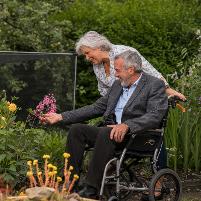A recent systematic review by Marasinghe et al. revealed that there is minimal evidence that the use of assistive devices by community-dwelling older adults (65 years and above) could reduce the amount of informal caregiving hours they receive. Only two existing cross-sectional studies by Agree et al. and Hoenig et al. have suggested a positive association between assistive device use by older care recipients (65 years and above) and a reduction in the amount of informal caregiving hours they received. One recent longitudinal study by Marasinghe et al. did not find an association between the two variables in this population (submitted).
The World Health Organization (WHO) defines assistive devices as technologies that are designed to help individuals maintain or enhance their ability to function independently, participate in activities, and improve their overall well-being. Assistive devices include but are not limited to mobility aids such as wheelchairs, walkers, and canes, visual aids, software and applications for communication and information management, and products classified under the 12 classes of assistive devices defined by ISO 9999 in collaboration with the WHO.
The term ‘informal care and support’ refers to the assistance that is provided by individuals who have a close relationship with someone who has a physical, cognitive, or psychological condition. This type of assistance is often provided without compensation by family, friends, or neighbours. Informal caregiving is a crucial measure of the intensity of caregiving; a high number of caregiving hours can result in physical, emotional, financial, and social difficulties for informal caregivers, which can adversely affect their overall health and well-being. According to research conducted in Canada, America, Australia, and the United Kingdom, informal caregivers who devote a significant amount of time to caring for others tend to experience negative effects such as stress, limited mobility, depression, anxiety, lack of exercise, poor dietary habits, increased alcohol consumption, chronic back problems, discomfort, reduced quality of life, insufficient time for personal and family life, decreased opportunities for education and employment, and overall poor health.
In the coming years, a greater need for in-home assistance is expected as populations continue to age globally. This demand can be partly explained by the increasing prevalence of health conditions that require extensive informal caregiving, which places a heavier burden on those who care for older adults. As a result, informal caregivers of older adults are at a higher risk of providing a significant amount of care. The demand for informal caregivers is also expected to rise due to changes in family dynamics, such as children moving away from intergenerational families to single-parent families or living alone, as well as demographics, such as low fertility rates and delayed childbearing. These factors are likely to reduce the ratio of caregivers to care receivers, resulting in a greater workload for available informal caregivers.
It has been proposed in the CATOR (Consortium for Assistive Technology Outcome Research) framework that reduced informal caregiving hours can be an outcome of assistive device use. Among the five assistive device outcomes defined by the CATOR framework, what is termed ‘the social significance vantage’ rationalises how assistive device use can affect society and other people, such as caregivers, by reducing the effort and time required to care for individuals using assistive devices. According to CATOR, using assistive devices may have the potential to promote independence of individuals, resulting in a decrease in caregiving time for informal caregivers. This reduction in caregiving time can lessen the burden and responsibilities of caregivers, giving them more freedom and flexibility in their daily lives.
The lack of empirical evidence regarding the relationship between assistive device use by community-dwelling older care recipients, and the amount of informal caregiving hours received, poses several challenges. Firstly, it limits our understanding of the impact of assistive devices, hindering the ability to make informed decisions regarding their use. Secondly, policymakers may struggle to make decisions about funding or recommending assistive devices in the absence of such evidence. Thirdly, it can be challenging to develop effective caregiver support programs that promote the use of assistive devices if they have not been shown to reduce informal caregiving hours. Finally, a lack of empirical evidence may also limit the ability to educate care recipients and caregivers about the potential benefits and drawbacks of utilizing assistive devices, potentially hindering their adoption, and limiting their possible benefits. Future research on the relationship between assistive device use by care recipients and informal caregiving hours is essential to improve the quality of life for both care recipients and caregivers. It can inform policy decisions, guide the development of assistive devices, and improve caregiver support programs, ultimately leading to better health outcomes and increased independence for both care recipients and informal caregivers.
About the Author
Keshini Madara Marasinghe is a Visiting Student at the Oxford Institute of Population Ageing. She is currently a Ph.D. candidate in Public Health and Health Systems (Aging, Health and Well-Being) at the University of Waterloo, Canada. She holds a Master of Public Health (MPH) from the University of Saskatchewan, Canada and a Bachelor of Science in Health Studies and Gerontology from the University of Waterloo.
Opinions of the blogger is their own and not endorsed by the Institute
Comments Welcome: We welcome your comments on this or any of the Institute's blog posts. Please feel free to email comments to be posted on your behalf to administrator@ageing.ox.ac.uk or use the Disqus facility linked below.













